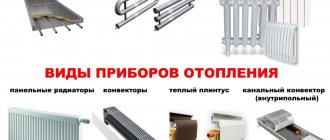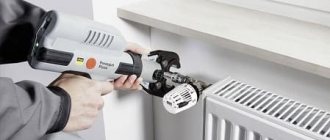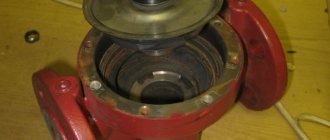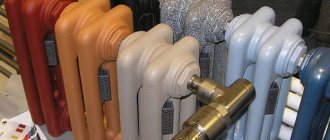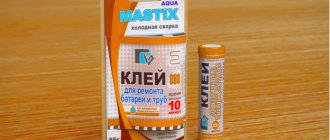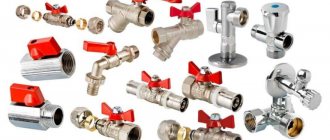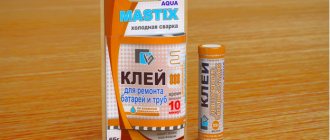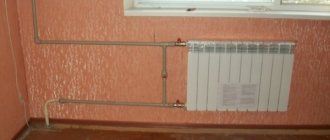Repairing a heating system is an expensive, complex, but necessary procedure. It must be carried out regularly, with a certain frequency, both in a city apartment and in private real estate. If you do not pay attention to this design, over time it will begin to fail until it falls into disrepair. The drop in pressure and temperature is just the beginning. The most tragic consequences are manifested in leaks and breaks in the main line. This is dangerous to health and is fraught with large material costs. The scope of repair of the heating system is determined by its age, degree of wear and existing damage. Based on the diagnosis, a decision is made on local or major intervention.
Carrying out work to ensure heat supply in apartment buildings
The main regulations that should be relied upon when resolving issues related to the restoration of the heating system:
- Decree of the State Construction Committee of the Russian Federation No. 170 “On approval of the Rules and Standards for the Technical Operation of the Housing Stock” (hereinafter referred to as PG of the Russian Federation No. 170) defines the types of repair work, the rules and regulations for their implementation, the list of works and who carries out them.
- Decree of the Government of the Russian Federation No. 491 (hereinafter referred to as RF PP No. 491) defines the “common property” of MKD. Details the elements to be repaired depending on the degree of wear. Regulates organizational issues.
- The Housing Code (hereinafter referred to as the Housing Code of the Russian Federation) explains the sources of financing for repairs and the features of contractual relations.
In accordance with clause 1.8 of the RF PG N 170, the following types of repairs can be carried out to maintain engineering systems in proper condition:
Let’s determine what their difference is, and what conditions create the prerequisites for each type of repair.
Capital works
Major repairs are a set of measures aimed at eliminating breakdowns of worn-out structural elements of the heating supply of apartment buildings, which are part of the common property. At the same time, work is being carried out to replace or restore them in order to bring them to current operational standards (Article 2 of Federal Law No. 185-FZ).
Prerequisites for carrying out a major overhaul of the heating system:
- development of the service life established by the standards (service life of steel heat supply communications - 25 years);
- a situation arises when individual space heating elements that are in common ownership violate the established maximum permissible reliability characteristics and create a safety hazard (clause 21 of RF PP No. 491).
What is included in the work to restore heat supply during a major overhaul (clause 7.2 STO NOSTROY 2.33.120-2013):
- Complete or partial replacement of intra-house heat supply lines, including risers, branches from risers into the apartment.
- Replacement of control and shut-off valves, including on the branches of risers to heating devices in apartments.
- Replacement of radiators in common areas (entrances, basements).
- Selective replacement of heating radiators in residents' apartments - in the absence of shut-off devices.
The last point of the above list is the most controversial. The fact is that heating radiators, in accordance with clause 6 of RF PP No. 491, are classified as common property, that is, those that serve more than one premises (Article 36 of the RF Housing Code). This means that residents who carry out repairs can theoretically qualify for a free replacement.
In practice, the owner of an apartment during restoration work can try to replace his heating device free of charge only if there are no disconnecting devices on the apartment riser, which will allow the radiator to be recognized as part of the general heating system.
Issues of organizing and carrying out major repairs of the heat supply system in the apartment building are entrusted to the management company. The work can be carried out either by a contractor or with the help of the company’s own personnel with the conclusion of a contract. The latter is more beneficial for residents, as it provides more guarantees against possible quality claims.
Current replacement of elements
It is carried out in a planned manner in order to prevent wear and tear of structural elements related to common property (clause 18 of RF PP No. 491).
The frequency of routine repairs for the heat supply system is not established by law. Repairs are carried out once every few years when deficiencies are identified during scheduled or seasonal inspections and require elimination.
Frequency of central heating inspections:
- scheduled - once a year (Appendix 1 of the RF PG N 170);
- seasonal - 2 times a year: in spring and autumn (clause 13.1 of RF Regulation No. 491).
Legal implementation of this type of repair is possible in two ways:
- The decision on repairs is made by the general meeting of residents on the basis of an inspection report if the residents of the apartment building wish to independently organize the work (clause 14, clause 18 of RF PP No. 491). The contractor is selected by the homeowners.
- Heating restoration work is carried out automatically, without the participation of residents. The contractor is the service organization to which the responsibilities for monitoring the heating network in the house are delegated.
The list of works during routine repairs includes the following measures for the restoration and replacement of individual elements of central heating (clause 11 of appendix 7 of the Russian Federation State Regulation No. 170 and clause 11 of appendix 2 of MDK 2-04.2004):
- Restoration or replacement of individual sections of risers, pipelines, shut-off and control mechanisms.
- Hydraulic testing of the heating system.
- Restoring the integrity of thermal insulation.
- Replacement of individual pumps or electric motors.
- Replacement of individual sections of heating devices.
- Partial replacement of sections of cast iron boilers, fittings, chimneys in the boiler room (if any).
Responsibilities for carrying out routine heating repairs “by default” are assigned to the management organization with which the owners of the apartment buildings have entered into a corresponding agreement (clause 16 of RF PP No. 491).
Troubleshooting
Emergency work on the heat supply system of an apartment building is carried out with the aim of urgently restoring the functionality of the heating system in the event of an accident. In accordance with paragraph 3 of Appendix 1 of MDK 2-04.2004, emergency maintenance of central heating includes the following activities:
- eliminating leaks in pipes, risers, heating radiators by sealing connections;
- repair or replacement of emergency shut-off valves;
- repair of emergency sections of the pipeline by repairing or replacing pipes;
- replacement of emergency pipeline sections up to 2 m long;
- welding work to the extent necessary to eliminate the malfunction.
Emergency faults of pipelines and connections in heat supply systems must be eliminated immediately (Appendix 2 of the RF PG No. 170).
Emergency heating work is included in the housing maintenance fee (Appendix 1 MDK 2-04.2004).
Who performs emergency work:
- during working hours, troubleshooting should be done by plumbers of management companies or housing offices servicing apartment buildings;
- during non-working hours, weekends and holidays - emergency repair services of organizations involved in servicing the housing stock (clause 7.7 of the RF PG No. 170).
Read more: Load-bearing walls in a Khrushchev-era two-room apartment
The legislative framework
Legislation on heat supply issues consists of the Constitution of the Russian Federation, as well as. The latter establishes the legal basis for relations related to the production, transmission and consumption of thermal energy.
Certain aspects are regulated by by-laws and decisions of local authorities.
Find out what the standard air temperature standards are for an apartment during the heating season.
Cost of replacement as part of a major overhaul
The legislation of the Russian Federation places the burden of payment for major repairs of apartment buildings (including replacement of heating) on apartment owners.
Is this included in the payments for major repairs?
Since 2014, residents must transfer funds monthly to a special fund, from which capital repairs are subsequently paid (Article 169 of the Housing Code of the Russian Federation). The amount of contributions for each owner is calculated individually by multiplying the tariff established in the region by the total area of the apartment. The law does not provide for a separate fee for major heating repairs.
Both current and major heating repairs are similar in that they are carried out as planned, but differ in scale and goals. Central heating elements that are in common ownership of the apartment building residents are subject to restoration work. The ultimate goal of the repair is the safe operation of the heating system.
If you find an error, please select a piece of text and press Ctrl+Enter.
A major overhaul of the heating system in an apartment building becomes relevant when there are frequent complaints from residents about the unsatisfactory quality of the services provided, in case of various leaks, or due to the old age of the equipment. Depending on the expected problems, various types of work are performed, the main task of which is to maintain the heating unit in proper condition.
Flushing the heating system in an apartment building
Household heat meters
establishes the obligation to equip apartment buildings with common house meters for water, electricity, heat and gas. They are usually installed in technical rooms (basements, utility rooms).
Using counters, you can record the amount of resources spent. At the same time, not only individual meters are installed for thermal energy, but also multi-tariff ones, which allows you to pay cheaper at night rates.
The management company is responsible for the maintenance of common house appliances. It monitors that utility bills correspond to the amount of resources consumed.
Find out how to install a communal heat meter in an apartment building.
Types of repair work of heating systems
Types of heating repairs in an apartment building can be divided into the following categories:
- Maintenance. The main part of the search for problems for this type of work is carried out during routine inspections of equipment in preparation for the heating season. During the period of special audits, minor defects in the system are identified, which are corrected taking into account the technical characteristics of the heating unit;
- major heating repairs are carried out after a certain period of operation of the building and include the dismantling and installation of new components instead of failed units. Here pipes, radiators, valves and other elements of the system can be changed;
- emergency repair. It is carried out urgently and includes work to eliminate emergency situations. This may include measures to eliminate various leaks that may appear as a result of ruptures in riser pipes, elevator plugs, or freezing of a piece of the system.
Preparatory work for the heating season is carried out during the shutdown of the system during the summer break in equipment operation. Water is drained from the structure, which makes it possible to carry out repairs without harm to the residents of the house.
Heating system of an apartment building
Types of materials for making radiators
- Radiators made of cast iron
. The biggest advantage of cast iron is its low cost; moreover, it is highly durable, which will increase its service life for many decades. The features of this design are designed for the purchase of radiators with a large number of sections in order to heat the room quickly and efficiently. - Batteries made of steel
. Such structures are characterized by a high level of heat transfer, and are also able to withstand high loads and corrosion; moreover, they are easy to install indoors and ensure maximum efficient operation. Steel radiators can be sectional or panel. Sectional radiators in appearance resemble cast iron batteries. Steel radiators are able to withstand a working pressure of 16 atmospheres and also have a long service life. The main disadvantage is the risk of damage due to water hammer or external mechanical impact, due to the relatively thin steel - 1.5 mm. - Bimetal batteries
. This type is considered the most innovative and modern, in addition, they are light in weight and have a pleasant appearance. Such a heating system can be installed independently and without the help of specialists, and the combination of two types of metals increases resistance to external and internal influences and ensures maximum heat transfer (read: “The best heating radiators for an apartment: classification”). Bimetallic batteries with a steel core and aluminum fins have 4 important properties: high mechanical strength, thanks to the high level - 16 atmospheres - working pressure and test pressure - up to 30 atmospheres; - the chemical stability of the core has the ability to form a galvanic couple with copper pipelines;
- high efficiency;
- the modern look is quite presentable. Aluminum radiators are lightweight, so battery installation can be done by one person. The positive qualities of radiators lie in the large number of product options that differ in functionality and form, as well as an immediate response to changes in water temperature. Disadvantages include the need for air removal and unacceptable contact of the coolant with other metals. If this rule is not followed, the radiator may be destroyed by chemical attack.
Maintenance
In preparation for the heating season, specialists from housing maintenance offices must carry out inspections of heating systems annually. But due to lack of personnel and funding, such events are often simply ignored. As a result, repair work can begin only after a written request from the residents of the house to higher authorities or after receiving a complaint. In the latter case, a commission is created and the following types of heating system repairs are performed:
- checking the operation of the elevator unit of the building and then resetting all valves and gate valves. If necessary, these parts are replaced with new ones. This can also include replacing oil seals and lubrication of rods;
- during the inspection of shut-off valves, worn gaskets are replaced;
- When repairing valves, spacer wedges are restored by grinding in the mirrors, replacing the pressure rings and restoring the rods. Purchasing new valves is not rational, they are very expensive, so this part will be repaired until the last minute.
A cast iron valve by its appearance will never indicate the need for repair, therefore, during routine repairs, the following types of work of a similar plan are carried out:
- checking the locking mechanisms of risers. If these elements are not working properly, then at the slightest damage or leak, it will be necessary to reset the entire house, and this is dangerous during winter frosts and can result in freezing of the system in many areas of the entrance;
- After certain periods of time, it is also necessary to check the fastening of the locknuts. This measure is necessary due to the fading of technical flax, and houses in which sealing was carried out with materials that are not afraid of fading were built in the last century.
But the main work of the team for routine heating repairs in an apartment building is to fully service the system, start it up and eliminate air jams during heating start-up, if residents from the upper apartments cannot do this on their own.
But to avoid bureaucratic delays, contracts are usually concluded between a home maintenance organization and its own repair teams. Workers carry out repairs during personal weekends or vacations. At the same time, the contractors themselves are interested in high-quality performance of the work, because in the event of unsatisfactory repairs, the consequences will have to be eliminated by them. During a major overhaul, the following types of work are performed:
- complete or partial replacement of heating lines or risers;
- complete or selective replacement of heating devices;
- replacement or installation of a new locking part of the elevator unit;
- complete or partial replacement of heating spills.
Using glue
Holes of small and medium sizes, cracks can be sealed. This option is temporary and is only suitable so as not to drain water from the riser or deprive the room of a heat source. After the heating season, the aluminum radiator must be removed in order to carry out high-quality repairs.
You can seal the hole using:
- Epoxy glue.
- Cement.
- A solution called “cold welding”.
Repairing holes with epoxy glue
To use epoxy resin glue, you need to prepare fiberglass or thick fabric. Since any of these materials must be wrapped around the radiator, the use of such adhesive is limited. After all, not every place can be wrapped easily and tightly. For some versions of aluminum radiators, this method is not suitable at all.
To seal holes or cracks:
- Cut the fabric into long narrow strips.
- Clean the area from which water is flowing. That is, remove all paint that has peeled off and all particles that are easily removed. This is done with a spatula. Next, take a brush with metal bristles and clean the surface. There should be pure metal left. It happens that a crack appears in a place where it is impossible to reach with a brush. An iron cable can help in this situation. It is pushed through the desired part of the radiator and pulled by the ends one by one, cleaning the desired area. This area is then dried.
- Apply glue to the treated area and wrap it with cloth.
- Apply glue to the fabric and wind another turn. This should be done until there are 4-5 turns. No glue is applied to the top layer of fabric.
- Secure the fiberglass using clamps or wire.
- Wait for the glue to dry. It dries from 2 hours to 3 days. If the room temperature is 20-25 °C, then it will dry in 2-3 hours.
To enhance the properties of the glue, you can add aluminum or bronze powder to it. Such powder is obtained by grinding off an unnecessary aluminum or bronze part with a rasp. Before use, the glue and powder must be mixed well.
Cracks are repaired in the same way using cement. However, medical bandages should be used instead of cloth. They need to be soaked in the solution and wound around the radiator.
We use “cold welding”
It is very convenient for sealing cracks and holes. This is a putty that looks like plasticine. There are two types:
- Single color.
- Two-color.
The first type is easier to work with, since you need to cut off the desired piece and knead it with your hands. You should wear gloves on your hands, because the putty is chemically active and can harm the skin.
Two-color cold welding must be mixed until a homogeneous solution appears. It becomes sticky while mixing.
The fight against holes using “cold welding” is carried out as follows:
- Clean the damaged area from dirt and paint.
- Knead the cut piece of “cold welding”.
- Apply the solution to the hole and rub it in (this is done with a metal spatula). To prevent the putty from remaining on the spatula, it must be moistened with water.
- If after grouting the cork begins to come out (a bubble forms, which then bursts), it must be rubbed again with a spatula. This may have to be done before the “cold weld” has completely dried. It dries in 5 minutes.
- Secure the plug with a clamp or rubber.
You can also seal the hole with heat-resistant sealant. However, you need to use the right sealant because there are acidic sealants that can corrode aluminum. Practitioners advise using neutral solutions.
Emergency repair
The name alone makes it clear that emergency work is carried out in situations where urgent assistance is required. Among the most common problems of this kind are:
- no riser heating. First, the locking mechanisms and valves are inspected; sometimes uncoordinated actions between residents and utility services lead to them simply being closed;
- There is no full water supply to the system. The cause may be an extra object getting into one of the pipes. It could be a piece of rust or slag stuck on a bend in the pipeline. After its elimination, the air is vented from the upper floors, and the system is put into operation;
- leak detection. If there is no threat of destruction, then the brigade’s responsibilities include the task of applying a fastening bandage to eliminate the leak. Next, welding work will be carried out by maintenance specialists.
When the system freezes, the entire riser is turned off and the location of the problem is carefully calculated; after it is detected, the pipe is heated to remove the cause of the malfunction.
Types of repair work of heating systems
Types of heating repairs in an apartment building can be divided into the following categories:
- Maintenance. The main part of the search for problems for this type of work is carried out during routine inspections of equipment in preparation for the heating season. During the period of special audits, minor defects in the system are identified, which are corrected taking into account the technical characteristics of the heating unit;
- major heating repairs are carried out after a certain period of operation of the building and include the dismantling and installation of new components instead of failed units. Here pipes, radiators, valves and other elements of the system can be changed;
- emergency repair. It is carried out urgently and includes work to eliminate emergency situations. This may include measures to eliminate various leaks that may appear as a result of ruptures in riser pipes, elevator plugs, or freezing of a piece of the system.
Preparatory work for the heating season is carried out during the shutdown of the system during the summer break in equipment operation. Water is drained from the structure, which makes it possible to carry out repairs without harm to the residents of the house.
Heating system of an apartment building
Stages of installation of heating equipment
For simplicity, let’s assume that you already have a heating supply project, the necessary equipment (radiators, pipes, fittings, insulation), you just need to install it in the apartment.
Call us and outline the problem. Our manager will ask you a few questions to clarify the scope of work and make an approximate calculation of the cost of heating in your case. Approximate, because the final cost will be clear on the spot, after measuring the length of the pipes, the number of connections and clarifying other details. Professional heating work always begins with an on-site analysis of the project. It is not always possible to implement a planned project, but you can get as close as possible to the desired result with minimal costs. For example, the pipes may not be suitable for the coolant in your home, then they will have to be replaced, along with the fittings. Or the selected beautiful radiators turn out to be too weak; in order to avoid leaks, we recommend strengthening or replacing them too. Our heating installation company provides a guarantee for all work carried out, because we care about your safety.
Maintenance
In preparation for the heating season, specialists from housing maintenance offices must carry out inspections of heating systems annually. But due to lack of personnel and funding, such events are often simply ignored. As a result, repair work can begin only after a written request from the residents of the house to higher authorities or after receiving a complaint. In the latter case, a commission is created and the following types of heating system repairs are performed:
- checking the operation of the elevator unit of the building and then resetting all valves and gate valves. If necessary, these parts are replaced with new ones. This can also include replacing oil seals and lubrication of rods;
- during the inspection of shut-off valves, worn gaskets are replaced;
- When repairing valves, spacer wedges are restored by grinding in the mirrors, replacing the pressure rings and restoring the rods. Purchasing new valves is not rational, they are very expensive, so this part will be repaired until the last minute.
A cast iron valve by its appearance will never indicate the need for repair, therefore, during routine repairs, the following types of work of a similar plan are carried out:
- checking the locking mechanisms of risers. If these elements are not working properly, then at the slightest damage or leak, it will be necessary to reset the entire house, and this is dangerous during winter frosts and can result in freezing of the system in many areas of the entrance;
- After certain periods of time, it is also necessary to check the fastening of the locknuts. This measure is necessary due to the fading of technical flax, and houses in which sealing was carried out with materials that are not afraid of fading were built in the last century.
But the main work of the team for routine heating repairs in an apartment building is to fully service the system, start it up and eliminate air jams during heating start-up, if residents from the upper apartments cannot do this on their own.
Major renovation
Before carrying out major work, first of all, a contract is concluded and a statement is drawn up, which sets out guidelines for the necessary materials and costs. Noi contracts are concluded in accordance with a strict procedure:
- The first step is to announce a tender for a more advantageous offer for the supply of materials, works or equipment. All enterprises providing this type of service can take part in the tender;
- after all tender registrations have been completed, contracts are concluded with a full list of future work, costs and guarantees laid out;
- after repairs are completed, depending on the satisfaction of the parties, payment is made or, if the outcome is poor, the case is sent to court.
But to avoid bureaucratic delays, contracts are usually concluded between a home maintenance organization and its own repair teams. Workers carry out repairs during personal weekends or vacations. At the same time, the contractors themselves are interested in high-quality performance of the work, because in the event of unsatisfactory repairs, the consequences will have to be eliminated by them. During a major overhaul, the following types of work are performed:
- complete or partial replacement of heating lines or risers;
- complete or selective replacement of heating devices;
- replacement or installation of a new locking part of the elevator unit;
- complete or partial replacement of heating spills.
Emergency repair
The name alone makes it clear that emergency work is carried out in situations where urgent assistance is required. Among the most common problems of this kind are:
- no riser heating. First, the locking mechanisms and valves are inspected; sometimes uncoordinated actions between residents and utility services lead to them simply being closed;
- There is no full water supply to the system. The cause may be an extra object getting into one of the pipes. It could be a piece of rust or slag stuck on a bend in the pipeline. After its elimination, the air is vented from the upper floors, and the system is put into operation;
- leak detection. If there is no threat of destruction, then the brigade’s responsibilities include the task of applying a fastening bandage to eliminate the leak. Next, welding work will be carried out by maintenance specialists.
When the system freezes, the entire riser is turned off and the location of the problem is carefully calculated; after it is detected, the pipe is heated to remove the cause of the malfunction.
Extraneous noise
Sometimes noise may occur in the heating pipes - it can be either a knocking in the heating pipes, or various clicks, and a hum. Why are heating pipes noisy? There are several reasons:
- During operation, the diameter decreases.
- Pipes are leaking.
- A smaller pipe diameter was installed.
You may need to think about how to fix a leaking heating pipe. When you eliminate the leak, you will also eliminate the problem of noisy heating pipes.
Why are the heating pipes still humming? This may be a reduction in pipe diameter. You can hear the heating pipes knocking right on the spot. You need to walk along the pipes and find the reason why the heating pipes are clicking. Usually the source from which the heating pipes click is located in the basement - because there is more pressure here
It is very important to find in time the reason why the heating pipes are shooting, humming or making noise - because this could be a prerequisite for a serious problem
What applies to major repairs of utility networks?
Thus, the engineering systems of an apartment building include:
- Overhaul of water supply and wastewater systems.
- Heating system. Most apartments have traditional radiators, which heat up when stable low temperatures arrive.
- Sewerage.
- Electricity.
- Ventilation system.
- Elevator system.
- Low-current networks, thanks to which it becomes possible to use the Internet, television, etc.
However, in order for all engineering systems to function in the correct mode, i.e. without failures, it is necessary to carry out certain work aimed at maintaining the condition of the vital systems of an apartment building.
Some of them are carried out on a regular basis and are ongoing, while some work is classified as capital. For example, a major overhaul of electrical wiring in an apartment building is being carried out. To make it clearer, let’s look at this classification in more detail.
Which radiator is better?
Among all the radiators that are sold in the store, choose the one that you would like to see in your room. It should fit into the interior, perhaps even be its exclusive part. Next, consider its characteristics.
The choice of radiators can be based on the following indicators:
- where are you going to install;
- radiator type;
- material;
- power;
- operating pressure;
- sectional or monolithic panel;
- exotic appearance;
- price.
You can choose such a radiator to suit your interior
Cast iron radiators last a long time, but they are heavy, initially require overhaul and replacement of gaskets, take a long time to heat up and have poor heat transfer. They cost not much less than bimetallic ones.
Bimetallic and aluminum radiators make no difference from a practical point of view. The operating pressure, even in high-rise buildings, does not exceed 10-12 atm and such radiators can easily withstand it. Look in the passport - the manufacturer indicates the working pressure and testing pressure, which is not less than 15 atm. This applies to houses with a riser system.
Current and major work in an apartment building
First, let's figure out what is the current repair of engineering systems, and what is a major one? Based on this, their difference from each other will be clearer, which is very important for understanding the issue itself.
Current repairs of engineering systems are carried out as planned, the purpose of which is to restore operability, partially restore their service life, which is expressed in the replacement or repair of certain components, which are expressly stated in the relevant regulations.
Such work is aimed at preventing wear, i.e. are in some way preventative.
Current work includes foundation repairs. This list includes: sealing seams and cracks, replacing foundation and wall cladding, repairing ventilation systems, etc., walls, roofs, replacing floor waterproofing, etc.
In a word, the current work is more like a cosmetic renovation, when the appearance of the building and entrance is partially restored.
The thing is that a major overhaul of the engineering systems of an apartment building means a complete replacement of these systems, each of which has its own operational life, after which major work must be carried out. In this case, the work will be carried out in the same areas as the current ones, but with a complete replacement of the main systems...
What sets our company apart from others
There are several reasons that make people turn to us:
- extensive experience of our craftsmen - we can perform all plumbing work without exception;
- commitment - having taken on a job, we bring it to the end;
- responsibility – we are responsible for the quality of our work;
- reasonable prices - we do not inflate prices so that our services are accessible to everyone;
- efficiency – we do our work not only efficiently, but also quickly;
- politeness – our dispatchers respect their clients, they will politely and thoroughly answer all your questions asked by phone;
- preliminary agreement – you can agree with us in advance about any plumbing work in your home, our specialists will carry it out at a time convenient for you.
By choosing our company, you can be sure that all work will be completed with high quality and on time.
Frequency
As mentioned earlier, each engineering system of an apartment building has its own service life. This information is clearly displayed in the technical regulations, which read as follows:
- Central heating system - 25 years.
- Replacement of hot water supply risers during major repairs - 30 years (if the risers are not galvanized, then 15 years).
- Cold water supply risers - 30 years (if the pipes are not galvanized, then 15 years).
- Overhaul of the power supply system - 20 years.
- Sewerage - 60 years (if the pipes are ceramic or plastic) and 40 years (if the pipes are cast iron).
- Roofing - depending on the material. Accordingly, a roof made of slate lasts 30 years, one made of galvanized steel - 15 years, and one made of rolled materials - about 10 years.
The above figures are the wear and tear of the main engineering systems of the building. Accordingly, capital work must be carried out after this period, including a complete replacement of the structural components of each system.
How to request ahead of time?
According to the regulations, major repairs of a building's engineering systems, for example, major repairs of a pipeline, can be carried out ahead of schedule only if a real threat to the life and health of the residents of a particular building is proven.
To make this possible, changes need to be made to the regional program, i.e. local government bodies, management organizations or homeowners' associations must submit an application to the relevant executive authority that deals with this issue.
Naturally, the decision to carry out major repairs earlier will be made only after a series of inspections and examinations of the condition of the building.
It is worth noting that to request repair of engineering systems you need to write a statement. It is designed in a free style according to the generally accepted pattern.
When starting to write an application, you should start by drawing up a header, which states to whom the application is being sent (position, company name), followed by the surname, first name and patronymic of the manager, the applicant’s initials, address and contact telephone number).
The body of the application states the essence of the problem (for example, a major overhaul of heating networks is required), indicates when the last inspection was carried out, and adds descriptions of the condition of engineering systems. This is followed by the date and signature of the applicant.
As a rule, you have to wait 10 working days for a response from the management company, which is REU, ZhEK or REMP.

